How to sell books online in 10 simple steps
Whether you want to sell old books you have lying around, take advantage of a rising trend, or self-publish something you wrote, it’s easier than ever to get started.
There are many benefits to selling books online, especially the low startup costs, the ability to reach a global audience, and the flexibility to focus on specific genres or types of books.
The key is to start and then continue building from there, and that’s what we’re going to help you with here. We’re giving you a step-by-step guide on discovering the right book niche, where to sell your books online, and how to promote them.
1. Research the online book market
The first step in learning how to sell books online is researching the market to understand what is selling.
This research will help you identify your target audience, what books you should sell, how to price them, and where you can reach your buyers.
Research the market
There are a few great ways to identify potential buyers and current trends:
- Track bestseller lists. Check the New York Times, Amazon, Goodreads, and LibraryThing, and note the most popular books and their genres.
- Monitor social media. Especially TikTok, where “BookTok” has gained significant influence in which creators discuss, review, and highlight books they’ve read.
- Use research tools. Google Trends can tell you what genres are trending, and Amazon Kindle Spy can give you a more in-depth picture of the online book market.
Identify your target audience
Through this research, you should note the type of people likely to buy the books you want to sell, including their age, hobbies, occupation, and interests.
You will also want to find out whether they prefer reading physical books or ebooks and where they prefer to buy them. This will help you make informed decisions about what type of books to sell, where to sell them, and how to present them to your buyers.
2. Choose the types of books to sell
The next step is to decide what types of books you want to sell.
Selling new books
You can source new books from wholesalers, publishers, and distributors. This is an excellent option if you want to offer your buyers the latest releases, but you will likely face higher startup costs, as most sources require minimum order quantities.
On the other hand, you might have the opportunity to sell your books in bulk. For example, if you sell textbooks or academic guides, your buyers could include libraries or schools.
Selling used books
Used books can be a more straightforward way to enter the market with a smaller investment. The best thing about this is that you can find used books just about anywhere, such as on eBay and Facebook marketplaces, as well as at local thrift stores, library sales, and yard sales.
Remember to source used books that are still in good condition. If you know what to look for, you can buy valuable, in-demand used books in excellent condition for below-market rates and sell them at a profitable markup.
Selling rare books
This market segment offers incredible opportunities for those already familiar with certain types of books. As these are rare and collectible, buyers are often willing to pay a premium, especially if they’re still in good condition.
Examples include first editions of vintage books, limited editions, signed books, and out-of-print books. Finding these rare titles requires a bit of luck, but you also need to know what to look for and where.
Selling ebooks and self-publishing
If you want to sell books that you write, some great platforms are available that make self-publishing possible. You can self-publish ebooks with Kindle Direct Publishing, giving your books great exposure to the massive Kindle marketplace. Authors who want to self-publish physical books can use platforms like Lulu or IngramSpark. These services streamline the entire process, from production to distribution.
3. Source your inventory
You can build your inventory of books through diverse channels. Each option presents unique opportunities, but the key is to know what your audience wants and to use a combination of sources to secure a profitable inventory.
Personal collection
For many people who want to start selling books, the quickest way is to sell books they already own. This easy option requires no investment and even helps you declutter your space.
The downside is that your inventory is limited to the number of books you own, which could become even more limited if you have sentimental items you’re reluctant to sell.
Wholesalers and distributors
You’ll need to work with wholesalers and distributors that sell in bulk to sell new books.
Research a list of reputable providers and look for companies that sell books within your niche. For example, Book Depot is more for general books and bestsellers, while Baker and Taylor Wholesale is an excellent source for academic books.
You will typically need to set up business accounts and meet minimum order requirements with each source. Some wholesalers and distributors also require you to have a registered business and EIN to buy books from them.
Library sales
Many libraries hold sales periodically to clear out old stock. These sales can be an excellent opportunity to pick up rare or out-of-print books at reduced prices, increasing your potential for higher profit margins.
However, you need to be prepared to sort through a lot of books to find those rare gems, and the irregular schedules of these sales means you might need other sources as well.
Auctions
Attending in-person and online book auctions can be a great source for undervalued rare finds.
This process can be exciting, but you should research titles beforehand to avoid overbidding. Also, be prepared to buy books in lots, where you might end up with unwanted books to find the one that makes it all worthwhile.
Used bookstores
An underrated way to source books is to build relationships with local used bookstore owners. These owners can offer bulk discounts or tell you about exciting acquisitions they’ve recently made.
Keep an eye on genres or collectibles that might be undervalued in the local market but could attract higher prices online.
Yard sales
Look for yard sales promoted online or in your local area with the potential for unexpected finds. Be sure to arrive early and check book values online before buying.
Visiting multiple sales could be time-consuming, and book quality varies everywhere, but you could find hidden gems that sellers don’t realize they have undervalued.
Estate sales
Estate sales can be an excellent source of rare and collectible books. They can be hit-and-miss, like yard sales, but there is greater potential for entire collections of specific genres or authors.
Estate sales can be found on local Facebook groups, in the classified ads section of local newspapers, or on websites like EstateSales.org.
Thrift stores
Visiting thrift stores can also be a good source of undervalued titles. Their inventory changes consistently, so look out for books in good condition that might have niche appeal online.
It might be time-consuming to search regularly, and the quality and selection might not be consistent, but their lower prices can make the higher margins worthwhile.
Tips for evaluating book condition
Properly evaluating book condition is essential for building an excellent reputation as a seller and keeping your customers happy.
If you’re selling on marketplaces, familiarize yourself with the selling guidelines first. When you list a book, write an accurate and clear description of its condition.
Here’s what to look for when evaluating a book’s condition:
- Check the cover, spine, and edges. Look for damage, wear, tears, or stains.
- Examine the pages. Loose or missing pages, tears, yellowing, annotations, or odors can impact the sale price.
- Check for any inscriptions. This can add value to the book, especially if it’s a collectible or rare book. Be sure to verify the publication date and the inscription.
4. Choose the right selling platform
The best places to sell books depend a lot on your specific circumstances and goals.
A third-party marketplace makes sense if you want to declutter your bookshelves by selling old books for extra money.
On the other hand, if you want to earn a living by selling books or at least make a decent side income, then these third-party platforms might not be ideal. There’s usually a lot of competition, the platform fees will reduce your profit margins, and you have limited control over your branding.
Build an online store
A better option if you want to build a book business is to start an online store. With your store, you have complete control over its design and branding, you can tailor the shopping experience, and you can build direct customer relationships.
Fortunately, with platforms like Hostinger’s AI ecommerce website builder, setting up your bookstore is simple.
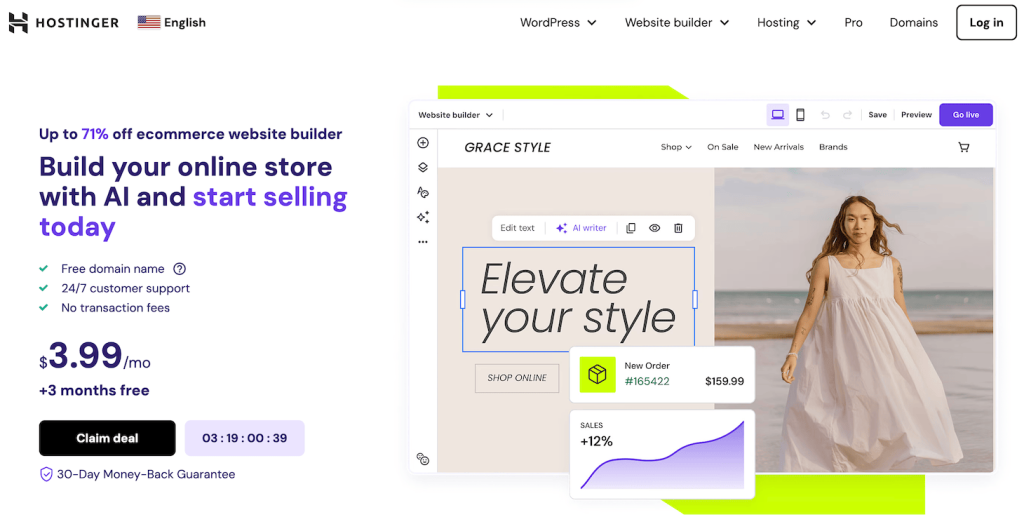
With the help of built-in AI tools, you can create an online store in minutes. Simply describe the types of books you sell and who your target audience is, and AI will create a professional-looking website for you.
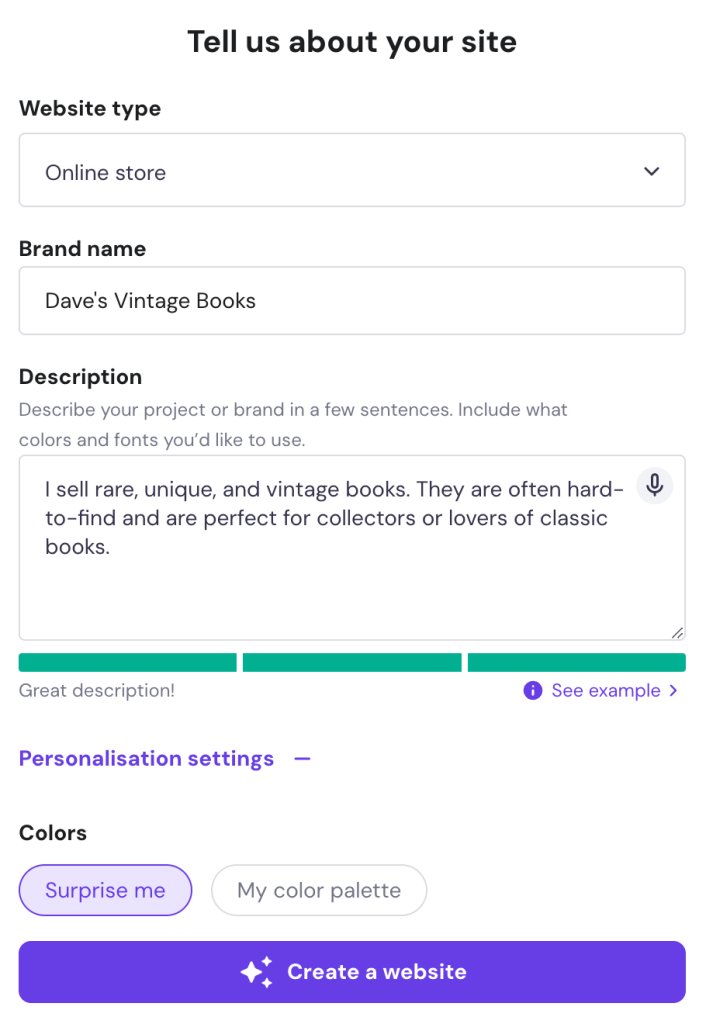
You can even create your logo with AI Logo Maker. Simply provide your brand name, select your ideal logo style, and choose your favorite design from the AI-created options.
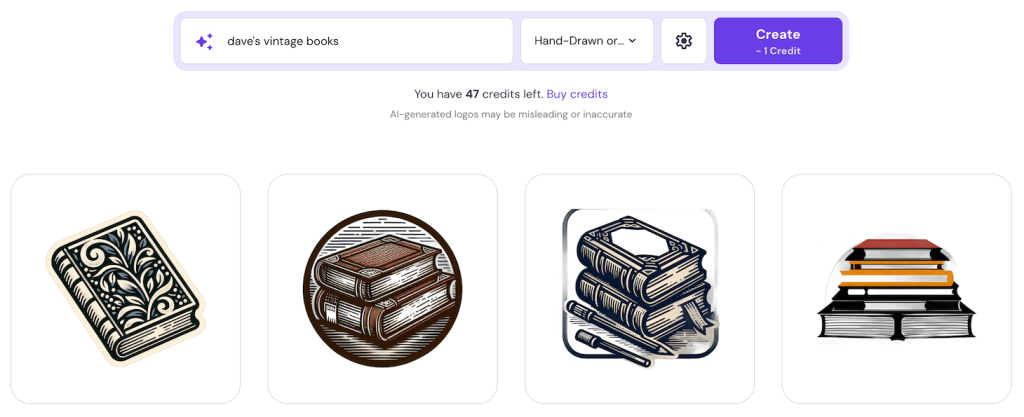
With a host of ecommerce features that allow you to sell up to 500 books in a simple and enjoyable way, Hostinger Website Builder is a great option for beginners.
Use a third-party platform
If you want to sell some books you have, using a third-party platform could be a good option. You can get started relatively quickly, you have an established audience to sell to, and these platforms have built-in trust.
Here are 5 top platforms to sell books online.
Amazon
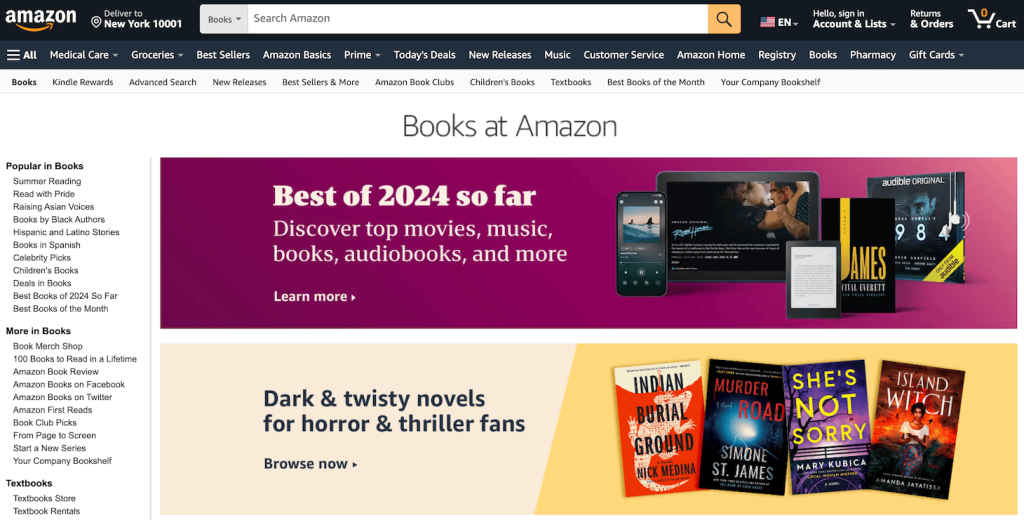
Best for: selling books with broad appeal
Amazon is the biggest online marketplace for selling books. It offers the largest potential reach but also the toughest competition.
You can sell new and used books here, as well as self-publish your own books in physical or digital format. However, if you want to stand out, you will need to sell unique books.
eBay

Best for: selling used, rare, or collectible books
eBay also has a large, active audience that you can leverage, giving you easy access to buyers worldwide. Selling on eBay in an auction format can lead to higher prices for rare or collectible books.
Still, like Amazon, there is a lot of competition, and you have limited opportunities to establish your brand.
BookDeal

Best for: selling textbooks
BookDeal is an online platform specifically for buying and selling old textbooks, which is excellent if you want to sell to a targeted audience of students and educators.
Selling on the platform is straightforward. You create an account, enter the ISBN (International Standard Book Number), and view offers. Once you accept an offer you like, simply print the shipping label and send the book out.
Powell’s Books
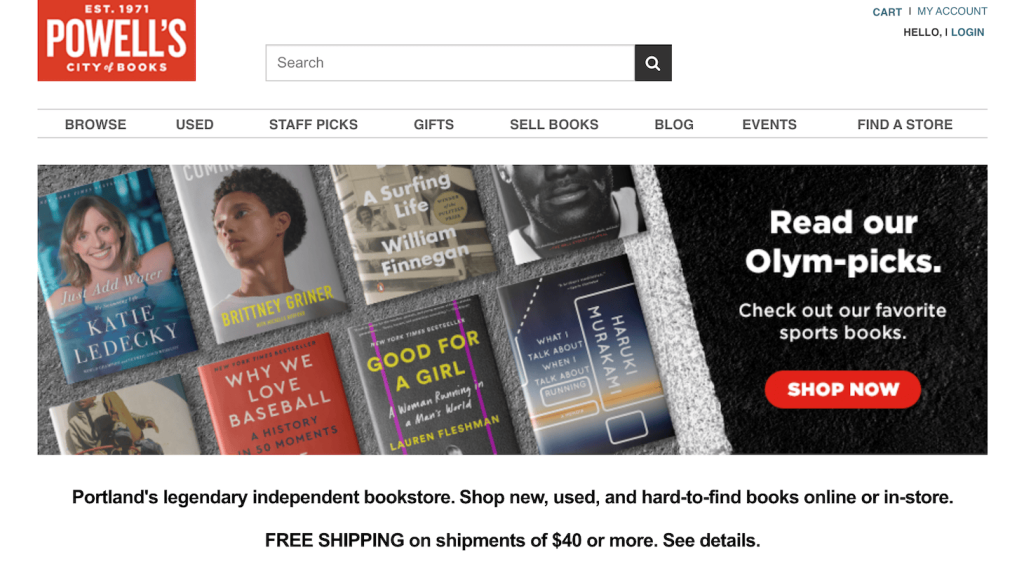
Best for: sellers with rare or unique books
Known as one of the largest independent bookstores in the world, Powell’s Books accepts a wide range of titles, including new, used, rare, and even out-of-print titles.
The selling process is also relatively straightforward as you sell the books directly to them rather than directly to the customers. Although their selection criteria can be pretty stringent, they offer competitive prices, especially for rare books in demand.
Alibris
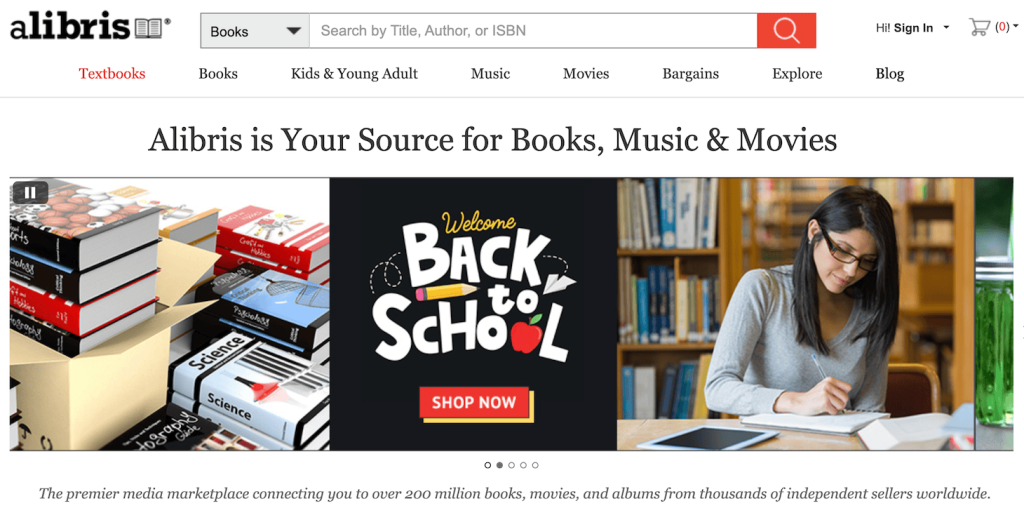
Best for: sellers with a more diverse range of inventory
Alibris is an online marketplace for individual sellers and professional booksellers. Its large worldwide customer base expands your potential reach, but like many online marketplaces, building your brand is a challenge.
Alibris doesn’t charge upfront fees for listing books but does take a commission on all sales.
5. Write compelling book descriptions
Writing engaging descriptions for your listings can significantly improve visibility and help to attract more buyers.
Here are several essential tips for writing appealing descriptions:
- Mention basic details about the book. Include information about the author, genre, publication year, and the number of pages.
- Provide a summary. Write a short, engaging summary of the book’s plot, but leave out any spoilers.
- Be transparent about the condition. For older books, it’s essential to be honest about flaws or general wear. This builds trust and helps to reduce the possibility of returns.
- Highlight any unique aspects. If the book is exceptional, like being a first edition or signed by the author, you should mention that.
- Showcase reviews or awards. Mention if the book or author has received glowing reviews or even been recognized with awards.
- Speak to your target audience. Use language your target audience resonates with, and indicate who would be interested in the book. For example, mention it’s “perfect for history buffs” or “ideal for sci-fi lovers”.
In addition to these tips, you should integrate relevant keywords naturally into your description. This will help people discover your listings more easily when searching for specific books.
Use tools like Google Keyword Planner or Helium 10 to identify relevant search terms.
If you decide to build an ecommerce website with Hostinger Website Builder, you can easily create engaging descriptions using AI.
Simply upload an image of your book and let AI Writer create a compelling title, subtitle, and description for you. Customize it to add your personal touch so the text is more engaging to your audience.

6. Take high-quality book photos
Presenting your books with high-quality photos is pivotal in conveying their value and attracting potential buyers.
Professional-looking photos add credibility to your listings, as shoppers see you are a committed seller who is serious about your presentation.
Clear, detailed photos also help build trust with buyers as it allows them to accurately assess the book’s condition, which is essential for sales and reduces the likelihood of returns.
Here are some helpful tips for taking professional-looking photos:
- Good lighting is vital. Natural light usually produces the best results, so try shooting on a bright day near a window. If good natural light isn’t available, consider investing in a simple lightbox that consistently helps you take clear photos.
- Capture the right angles. You want to be transparent with your buyers and showcase your books from all sides so they can properly assess the book’s condition. Straight-on shots of the front, spine, and back cover are essential. In addition, don’t forget to take close-up shots of unique features, such as illustrations or author signatures, and any flaws buyers should be aware of.
- Stick with clean, neutral backgrounds. Ensure that the background complements the book rather than distracting from the book. Neutral colors work well for most books, providing a smooth, distraction-free setting.
- Do some basic photo editing. Use simple tools to adjust brightness or contrast, crop images to remove distracting elements, and apply light-sharpening effects to enhance details.
- Be consistent with your style. Maintain the same photography style across all your listings to build brand recognition for your online bookstore.
Implementing these techniques can help you showcase your books more effectively, potentially leading to better conversions and more sales.
7. Set competitive prices
Setting the best price is vital to making sales and earning a profit. The main factors that impact book pricing are its condition, rarity, and demand.
- Condition. Used books in good condition, with no wear and tear, often attract higher prices than books with minor wear or defects.
- Rarity. Rare books, including first and special editions, books signed by the author, and limited edition copies, also attract higher prices.
- Demand. Some books, like academic texts, have steady demand, while demand for other books fluctuates based on factors like author popularity, seasonal interests, and media mentions.
Monitor competitor prices
It’s a good idea to monitor the prices of similar listings on different platforms.
Look at the condition of competitor books, their seller ratings and reviews, and any unique values they offer, such as faster or even free shipping.
Keeping track of competitor prices will help you determine a price range for selling your books.
Consider your costs
When setting your prices, you also want to consider these factors:
- Your acquisition costs. Consider factors like the price you paid for the book, shipping, and any repair or cleaning costs.
- The shipping costs. Not just the cost of postage but also the expenses you incur for packaging materials and handling time.
- Platform selling fees. This varies from platform to platform, as do payment processing fees for services like PayPal or Stripe.
Tips for setting profit margins
All of the above factors will influence your profit margins.
You might be able to set higher profit margins if you have rare or valuable books or if your books are in better condition. On the other hand, lower margins might be more appropriate for common books or if you want a quicker sale.
Be dynamic with your pricing and adjust it based on competitor pricing changes, stock levels, and seasonal demand.
8. Fulfill customer orders effectively
A smooth fulfillment process is also essential to selling books online. It helps ensure customer satisfaction and can turn buyers into loyal customers.
Let’s look at the different aspects you need to consider when fulfilling orders.
- Choose suitable packing options. To ensure the books arrive in perfect condition, wrap them in bubble wrap to protect covers and corners. Another option is to use padded envelopes or appropriately sized boxes, with packing peanuts or crumpled paper filling empty spaces.
- Use shipping methods that balance speed and cost-effectiveness. For more common books, an economical option might work where it takes longer for delivery, but the costs are lower. Choose carriers offering expedited shipping and more detailed tracking for more valuable books. The latter option might cost more but will likely lead to better customer satisfaction.
- Manage your shipping costs. Determine your costs for each book based on weight and destination. Most carriers provide shipping calculators you can use to determine your costs. When setting the price for your shipping options, remember to factor in the cost of the packaging materials you use. Offering free shipping on orders over a certain amount could also encourage larger purchases.
- Use a reliable delivery system for ebooks. Selling on established platforms like Amazon Kindle Direct Publishing or Smashwords simplifies the fulfillment process for you and your customers, as buyers can download the ebook immediately. Just make sure everything is set up correctly before any sales come through.
How to keep customers happy
Being as clear as possible upfront helps to boost customer satisfaction. Here are some other vital factors to consider to keep your buyers happy.
- Provide a transparent and fair return policy. Clearly state how long customers have to initiate a return and specify that books must be in the same condition they were shipped in when returned. Also, decide who will cover the return shipping expenses and outline a timeframe for processing refunds.
- Respond to inquiries promptly. Schedule time to respond to emails and messages throughout your day, and aim to reply within 24 hours.
- Keep customers in the loop. Providing updates on when books will be shipped, tracking information, and keeping customers updated on any updates to their orders goes a long way to ensuring customer satisfaction.
- Follow up after expected delivery. A few days after the customer receives the book, email them to ensure they are satisfied with their purchase and address any negative feedback.
From careful packing to anticipating customer needs, you want to ensure a smooth transaction and create a positive buying experience.
9. Market and promote your books
Successfully selling books online requires a combination of effective marketing strategies and engaging content.
By implementing these strategies and continuing to refine the content for your audience, you can quickly build a solid online presence and gain a loyal customer base.
Here are a few of the most effective marketing strategies you should try:
- Search engine optimization (SEO). Identify keywords related to the books you want to sell, then incorporate those keywords naturally into your book listings. Use tools like Google Keyword Planner to research the right keywords.
- Social media marketing. A wide variety of social media platforms cater to different demographics. The key is to speak to your specific target audience on each platform. Create visual content around book covers and quotes for Instagram, X, and Pinterest. Meanwhile, TikTok is great for short reviews and creative recommendations.
- Email marketing. Build an email list of buyers and people who subscribe to your newsletters. Segment your list to send them curated book recommendations, new releases based on their interests, and exclusive discounts.
- Paid advertising. Reach potential buyers with targeted ads on platforms like Google Ads, which is built into Hostinger Website Builder, or Facebook Ads. These platforms are a great place to start, allowing for specific targeting based on demographics, interests, and search terms. In addition, you only pay for each click-through to your page. You should monitor your budget carefully, though, to ensure you’re getting a good return on your marketing money.
- Blogging. Starting a book blog can provide great value to your audience and can also help attract more visitors through SEO. The content can include book reviews, discussions about the themes in specific books, or commentary on authors. Regular blogging
When using Hostinger Website Builder, creating engaging content is effortless with the help of AI Writer. For a blog or even for shorter snippets for social media, simply describe the content you want to write, and AI Writer will create the content for you.

10. Track sales performance
Tracking and analyzing sales data will help you gain valuable insights about how to increase sales. You can identify market trends, analyze pricing strategies, and better understand your customers.
By leveraging these insights, you can make informed decisions that can lead to more sales for your store.
Key metrics to track
Here are the primary data points you want to keep an eye on:
- Overall sales volume. Monitor the number of books you sell weekly and monthly to identify sales patterns and make decisions for growth.
- Bestselling titles and genres. Track which books and categories are most popular with your customers to inform your inventory decisions.
- Customer acquisition cost. Measure the cost of attracting each new customer to ensure your marketing strategies are cost-effective.
- Customer lifetime value. For insights into customer retention, identify how much revenue each customer spends on average over their relationship with your business.
- Conversion rate. To gauge your listings’ effectiveness, monitor the percentage of website visitors who convert into buyers.
- Return rate. Analyze how many orders are returned to address quality issues.
Tools for tracking and analyzing sales data
Fortunately, a wide range of tools can help you track this data. Here are a few of the best to use:
- Google Analytics. This free tool provides in-depth data on your website traffic and user behavior.
- Built-in ecommerce analytics. A lot of online platforms offer their own analytics dashboards that provide insights into your sales performance.
- Hostinger Website Builder analytics. When you build an online bookstore with Hostinger Website Builder, you gain deeper insights into areas of success and improvement with Store Analytics.
Conclusion
Selling books online can be a great way to clear your bookshelves or start a new business. With low startup costs and a global audience within reach, you can start selling books quickly.
Let’s recap how you can get started:
- Research the online book market. This initial step will help you identify your target audience and the market’s trends.
- Decide what books you want to sell. This can include new books, used books, rare books, or even self-published ebooks.
- Build an inventory of books. You should be consistent with the quality and know what your audience is looking for.
- Choose where to sell your books. You can sell on various third-party marketplaces or establish a bookstore with a powerful tool like Hostinger Website Builder.
- Write engaging product descriptions. This will help with visibility and attract the right buyers. Use AI Writer with your online store to simplify the process.
- Take high-quality photos of your books. Present your books in the best possible way to add credibility to your listings.
- Set appropriate prices. Identify a competitive price range that considers your book’s condition, the demand, and your costs.
- Establish a smooth fulfillment process. Making this process as seamless as possible will make it easier for you and will likely keep your customers happy.
- Promote your books. Create engaging content for your blog and to distribute on social media to attract buyers to your listings.
- Track your sales performance and make improvements. Monitoring sales data helps you make informed decisions that can lead to more book sales.
Whether you want to sell some used books or build a great book business, the steps outlined here will help you get started on this incredible journey.
FAQs
Is selling books online profitable?
Selling new or used books online can be profitable. However, your success depends on various factors, such as identifying a popular niche, building a loyal customer base, and following the steps outlined here will go a long way to helping you succeed online.
How much does it cost to sell books online?
The costs of selling books can vary widely, and a lot of them depend on your goals.
If you want to just clear out your bookshelves, your costs will be limited to marketplace listing fees and shipping. On the other hand, if your goal is to start your own website, you will need to consider costs like a domain, hosting, inventory, shipping, and marketing.
It’s a good idea to start small, track your progress, and make informed decisions as you grow.
What is an ISBN?
An ISBN, or International Standard Book Number, is a unique number series that helps identify books and other publications. It is essentially a book’s “fingerprint” and is important for publishing and commerce.


